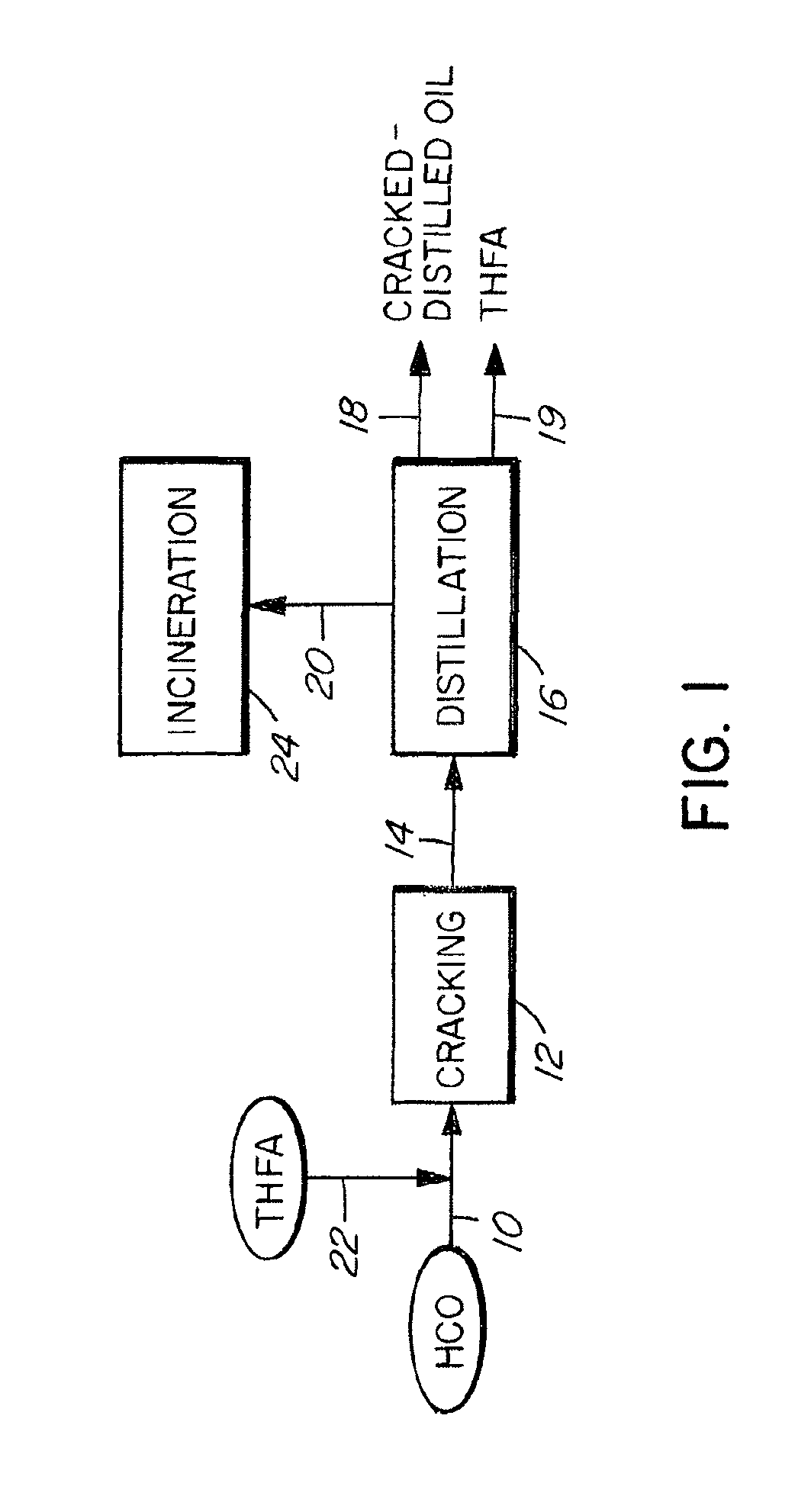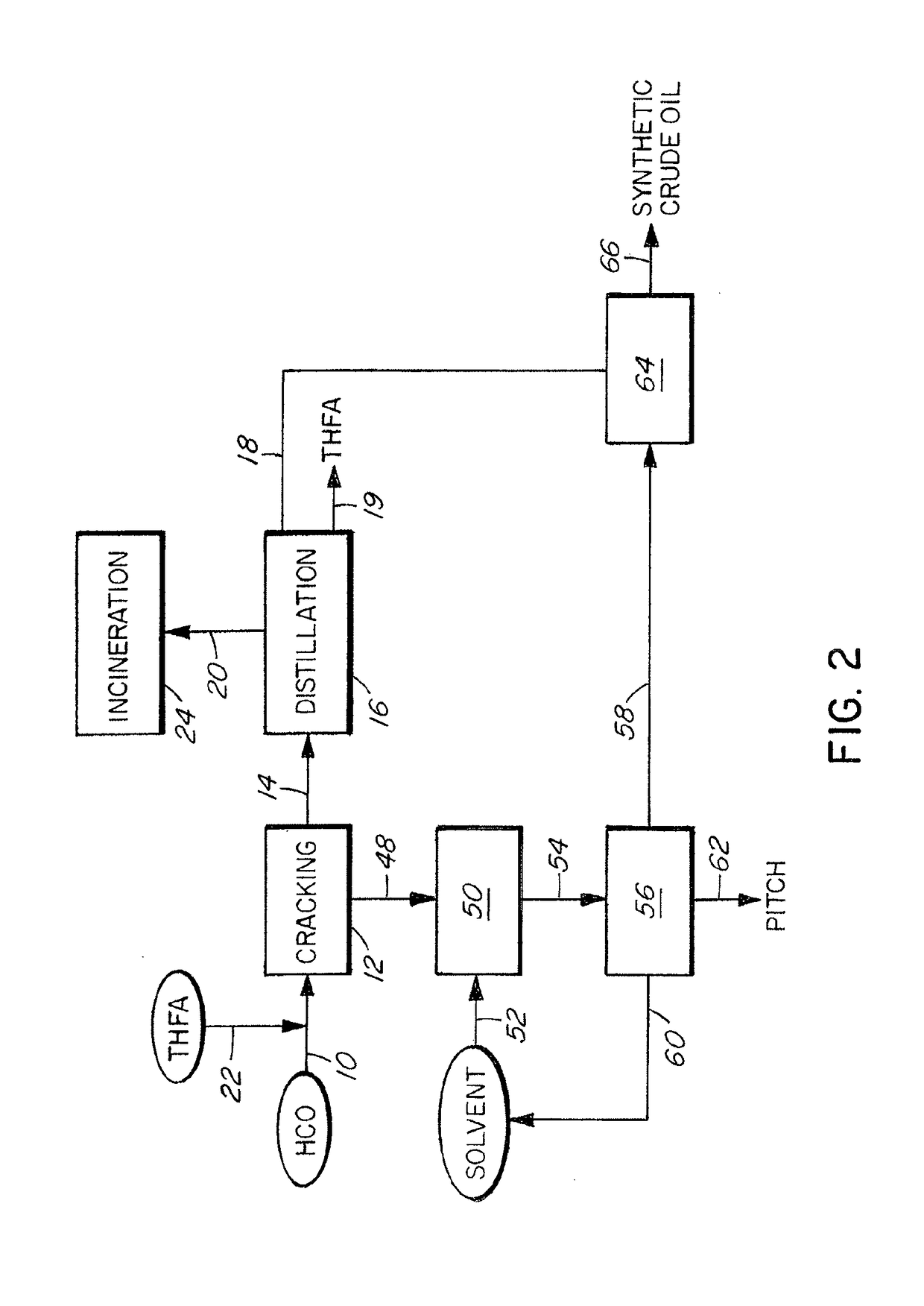Method of upgrading heavy crude oil
a technology of heavy crude oil and upgrading method, which is applied in the direction of hydrocarbon oil treatment, hydrocarbon distillation, cracking process, etc., to achieve the effect of reducing or eliminating undesirable coke formation, increasing the conversion rate of heavy crude oil, and high boiling point component conversion of the present invention
- Summary
- Abstract
- Description
- Claims
- Application Information
AI Technical Summary
Benefits of technology
Problems solved by technology
Method used
Image
Examples
example 1
Simultaneous Thermal Cracking and Distillation of Athabasca Bitumen with Sequential Solvent Deasphalting with and without THFA
[0061]Athabasca bitumen was subjected to three cracking and solvent deasphalting treatments:[0062]Run A: conventional visbreaking treatment;[0063]Run B: treated according to the present invention, without THFA;[0064]Run C: treated according to the present invention, with THFA.
[0065]Conventional visbreaking, Run A, was carried out in a pressurized, stirred stainless steel autoclave for 1050 seconds at an equivalent temperature of 410-412° C. The reaction product was cooled rapidly to room temperature and the resulting gas product was analyzed. Gas yield in weight % of the HCO feed was 13.6%. Although Run A may be distinguished from other visbreaking processes by its temperature and severity of the operation, for present purposes the severity of a process can be compared using the following equation:
[0066]θ875°F=60×exp[(Ea×1.81.987)(1875+840+17°F+460)]
W...
example 2
Simultaneous Thermal Cracking and Distillation of Lloydminster Heavy Oil with and without THFA
[0084]Two samples of HCO from Lloydminster, Alberta, Canada, were heated for 2 hours at 150° C. followed by atmospheric pressure cracking-distillation, Sample 1 having 10 parts by weight THFA per 90 parts by weight HCO, and Sample 2 having no THFA. Sample 1 was aerated and stirred with a magnetic Teflon®-coated stirrer bar during the heating step prior to distillation. The THFA-HCO mixture was stirred during cracking-distillation. The samples were heated until excessive foaming occurred in the distillation apparatus. Cracking-distillation was carried out using the apparatus described in ASTM method D86, allowing continuous exhausting of volatile components that are not condensed by the water-cooled condenser. The initial and final boiling points for atmospheric pressure distillate (CDO) of Sample 2 were 143° C. and 342° C., respectively. The initial and final boiling points for the atmosphe...
example 3
Simultaneous Thermal Cracking and Distillation of Lloydminster Heavy Oil with and without THFA
[0097]Sample 3, having the same HCO used in Example 2, was cracked-distilled in similar fashion to Example 2 above, to determine the effect of THFA on distillate density (e.g. API gravity) and viscosity. Sample 3, consisting of a THFA-HCO mixture having 10 parts by weight THFA per 90 parts by weight HCO, was heated for 2 hours at 150° C. with aeration and stirring, followed by atmospheric pressure distillation. The results are as follows:[0098]201% increase in API gravity of Sample 3 CDO vs. undistilled HCO feed (i.e. API gravity of 9.3 for undistilled HCO feed vs. API gravity of 27.0 for Sample 3).[0099]99.9% reduction in viscosity of Sample 3 CDO vs. undistilled HCO feed (i.e. viscosity of 93 cp for Sample 3 vs. 82200 cp for undistilled HCO feed).
[0100]These results clearly show the value of adding high boiling point THFA alcohol-ether to HCO, especially high-sulphur HCO, (i.e. sour heavy...
PUM
| Property | Measurement | Unit |
|---|---|---|
| temperature | aaaaa | aaaaa |
| pressure | aaaaa | aaaaa |
| pressure | aaaaa | aaaaa |
Abstract
Description
Claims
Application Information
 Login to View More
Login to View More - R&D
- Intellectual Property
- Life Sciences
- Materials
- Tech Scout
- Unparalleled Data Quality
- Higher Quality Content
- 60% Fewer Hallucinations
Browse by: Latest US Patents, China's latest patents, Technical Efficacy Thesaurus, Application Domain, Technology Topic, Popular Technical Reports.
© 2025 PatSnap. All rights reserved.Legal|Privacy policy|Modern Slavery Act Transparency Statement|Sitemap|About US| Contact US: help@patsnap.com



